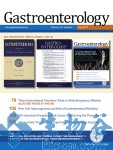Gastroenterology:新口服抗凝药增加消化道出血风险好医师网24小时在线答疑
关键词:口服抗凝药丨消化道出血
新一代的口服抗凝药包括凝血酶和Xa因子的抑制剂,均显示较好的抗凝效果。但是不明确这些药物是否会增加患者消化道出血的风险。需要频繁服用口服抗凝药的患者会有一些显着的合并症,并且可能会服用阿司匹林和/或噻吩并吡啶。
来自荷兰的Lisanne Holster医生对于服用抗凝药的患者发生消化道出血的风险及临床相关的出血进行了一项系统性综述和荟萃分析。43项随机对照研究比较了抗凝药和标准治疗发生消化道出血的风险,研究团队纳入分析了这些数据。比值比(OR)通过随机效应模型进行评估。研究发现服用抗凝药患者消化道出血风险的总OR值是1.45,但这些纳入的研究之间存在显着的异质性。亚组分析显示房颤的OR值为1.21,整形外科术后预防血栓的OR值为0.78,治疗静脉血栓的OR值为1.59,治疗急性冠脉综合征得OR值为5.21。
研究者对于不同药物进行了分析评价,阿哌沙班的OR值为1.23,达比加群的OR值为1.58,依杜沙班的OR值为0.31,,利伐沙班的OR值为1.48。服用抗凝药患者发生临床相关出血的总OR值为1.16,在亚组分析中呈现类似的趋势。
Holster医生团队总结认为,“治疗静脉血栓和急性冠脉综合症的研究显示,与接受标准治疗相比,服用抗凝药的患者发生消化道出血的风险增加”。“将来一些消化道出血事件更好的报道有助于对患者进行分层治疗,可采用保护消化道的药物”。(生物谷Bioon.com)
生物谷推荐英文摘要:

Gastroenterology doi:10.1053/j.gastro.2013.02.041
New Oral Anticoagulants Increase Risk for Gastrointestinal Bleeding: A Systematic Review and Meta-analysis
I. Lisanne Holster Vera E. Valkhoff, Ernst J. Kuipers, Eric T.T.L. Tjwa
Background & Aims
A new generation of oral anticoagulants (nOAC), which includes thrombin and factor Xa inhibitors, has been shown to be effective, but little is known about whether these drugs increase patients’ risk for gastrointestinal bleeding (GIB). Patients who require OAC therapy frequently have significant comorbidities and may also take aspirin and/or thienopyridines. We performed a systematic review and meta-analysis of the risk of GIB and clinically relevant bleeding in patients taking nOAC.
Methods
We queried MEDLINE, EMbase, and the Cochrane library (through July 2012) without language restrictions. We analyzed data from 43 randomized controlled trials (151,578 patients) that compared nOAC (regardless of indication) with standard care for risk of bleeding (19 trials on GIB). Odds ratios (ORs) were estimated using a random-effects model. Heterogeneity was assessed with the Cochran Q test and the Higgins I2 test.
Results
The overall OR for GIB among patients taking nOAC was 1.45 (95% confidence interval [CI], 1.07?1.97), but there was substantial heterogeneity among studies (I2, 61%). Subgroup analyses showed that the OR for atrial fibrillation was 1.21 (95% CI, 0.91?1.61), for thromboprophylaxis after orthopedic surgery the OR was 0.78 (95% CI, 0.31?1.96), for treatment of venous thrombosis the OR was 1.59 (95% CI, 1.03?2.44), and for acute coronary syndrome the OR was 5.21 (95% CI, 2.58?10.53). Among the drugs studied, the OR for apixaban was 1.23 (95% CI, 0.56?2.73), the OR for dabigatran was 1.58 (95% CI, 1.29?1.93), the OR for edoxaban was 0.31 (95% CI, 0.01?7.69), and the OR for rivaroxaban was 1.48 (95% CI, 1.21?1.82). The overall OR for clinically relevant bleeding in patients taking nOAC was 1.16 (95% CI, 1.00?1.34), with similar trends among subgroups.
Conclusions
Studies on treatment of venous thrombosis or acute coronary syndrome have shown that patients treated with nOAC have an increased risk of GIB, compared with those who receive standard care. Better reporting of GIB events in future trials could allow stratification of patients for therapy with gastroprotective agents.
(责任编辑:heyifei)
您还可以这样阅读



















